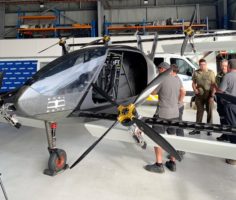Sydney startup AMSL Aero has built a battery-powered Vertical Take Off and Landing (eVTOL) aircraft with a cruising speed of 300kmh that could hit the skies as an air ambulance in 2023.
The Vertiia eVTOL prototype, developed in conjunction with University of Sydney researchers and Australian aeromedical company, CareFlight, can travel at twice the speed of a helicopter and is much quieter.
As well as electric power, the Vertiia will also run on hydrogen, with a range of 250km under battery and an impressive 800km using hydrogen.

The Vertiia prototype. Photo: supplied
Initial plans for its rollout in three years will be as an ‘aero-ambulance’ for CareFlight to transport emergency patients from rural and regional areas to hospital. Test flights at Narromine Airport in regional NSW will begin shortly. Commercial use of the Vertiia still needs approved by the aviation regulator, CASA.
Between vertical landing and take offs like a helicopter, the electric eVTOL then adopts a plane-like, faster fixed-wing flight while cruising. The Australian-built project is similar to Uber’s air taxi project, which has earmarked Melbourne as one of three trial sites.
The company says its aircraft is not only safer than helicopters but also significantly quieter than combustion engine aircraft – similar to a Tesla v regular car.
AMSL Aero founder and CEO Andrew Moore said the Vertiia is currently piloted, but they are developing technology to make it autonomous, including landing in low visibility and bad weather.
“Its low operating cost and high speed will reduce rural and regional road trips, reduce transport fatalities, and reduce the cost of maintaining and building new transport infrastructure,” he said.
“Vertiia’s use of hydrogen [in addition to electricity] will put us at the forefront of de-carbonised transport development globally. It will also provide air transport that is resistant to global oil price fluctuations and interruptions.”
At stake is a market predicted to be worth more than $7.5 billion, including $6 billion in urban air travel. Moore hopes to build his craft in Australia.
Associate Professor Dries Verstraete, an aerospace engineer at the University of Sydney, is leading the team with expertise in hydrogen propulsion who are focused on increasing the aircraft’s efficiency and reduce overall operating costs.
“My team has used computers to design and algorithms to optimise the aircraft structure and its propellers. This will ultimately allow AMSL Aero to reach their ambitious range and speed targets for Vertiia,” he said.
Assoc Prof Verstraete believes it will be a natural successor to the helicopter and the biggest benefit will come in healthcare.
“Regional and remote patient transfer can often be complicated and slow: often, patients must be taken to the airport in an ambulance, transferred onto a plane, and then back into another ambulance, whereas Vertiia aims to transfer patients from door-to-door,” he said.
Project partner CareFlight, believes the innovative technology will bring significant benefits to patient outcomes: with Vertiia, clinical services can be delivered faster, particularly in conditions adverse to traditional aviation such as poor weather and unprepared landing sites in remote areas.
CareFlight General Manager of Operations, Craig Gibbons, described Vertiia’s use of hydrogen power – and future use of pilotless aircraft technology – as ingenious.
“The solution will be of great benefit to patients, and with its tiny carbon footprint, has the bonus of being great for the planet,” he said
Launched in Sydney this week, the Vertiia received a $3 million federal government Cooperative Research Centres Projects grant.




















Trending
Daily startup news and insights, delivered to your inbox.